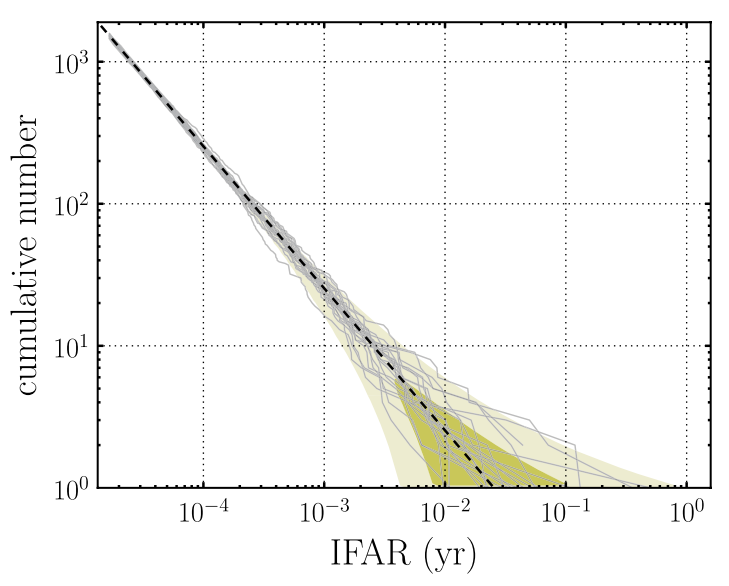Michele's blog
Three new articles
2013/01/11

Distribution of triggers (candidate detections) in a search for inspiral GWs. Stronger candidates have high IFARs (the number of years that you'd have to wait to see one such trigger from noise alone). From PRD 87, 024033 (2013).
It seems that I have been getting new papers out faster than I could blog about them, so let me catch up with this post. The first is a LIGO paper, the second may be my last LISA paper for a while, and the third is about the statistical theory of extracting information from gravitational-wave signals. All three will be published in 2013, and all three are... good stuff.
Searching for gravitational waves from binary coalescence. This paper was posted the arXiv back in August, and it's actually already in print as Phys. Rev. D 87, 024033. Although the paper carries a large author list (a significant subset of the LIGO/Virgo working group on compact-binary-coalescence detection, or CBC), I'm rather proud of it. It describes the CBC workhorse software pipeline, ihope, which I helped to build, and which I used, with many others, to search for CBC GWs in the last two LIGO science runs.
The paper gives details about all the steps that take you from the idealized mathematical formulation of the detection problem to a real-world search, which is implemented on large computer clusters, and which needs to deal successfully with the nonideal behavior of detector noise. For instance, noise values that are not neatly distributed with a Gaussian curve but have large, sudden glitches and power fluctuations.
Testing general relativity with low-frequency, space-based gravitational-wave detectors. This paper (arXiv 1212.5575), which I put together with my friends and colleagues Jon Gair, Shane Larson, and John Baker, is an extensive living review (92 pages, covering 407 references!) of the fundamental tests of general relativity that will be possible with a space-based detector. Indeed, these tests will be manifold and unique, covering aspects such as the generation, nature, and propagation of gravitational waves, and the structure and possible hairiness of black holes.
When this paper was commissioned, it was entitled simply "Testing general relativity with LISA," but given recent programmatic developments that pushed LISA (or whatever it will be called) to the second half of the 2020s, a more generic title seemed appropriate. The mechanics of working on such a long paper with three other busy and geographically sparse researchers were not easy, so it took a very long time, but I'm satisfied with the result, although the "living" character of the review means that it will never be truly finished. I hope some of us will have the strength to update it in a few years, maybe in celebration of a new start for a GW mission.
Stealth bias in gravitational-wave parameter estimation. This paper (arXiv 1301.2627) was born in discussions with Nico Yunes at a workshop in 2011. Npw, I've long been critical of Yunes and Pretorius' parametrized post-Einstein" framework, which augments the waveforms that we use to detect compact-binary inspirals with extra parameters that model the effects of alternative, non-general-relativistic theories of gravity. My criticism was that the prospects to detect non-GR effects in GWs will always be unclear unless we can determine the interplay between these and the effects of slightly changing the physical parameters of GW-emitting systems (such as masses and spins in a binary) in just the right way to reproduce the non-GR correction. This paper clarifies that very point: given a non-GR effect of a certain "shape," it provides a process to identify the systems in which the effect will be detectable (using Bayesian model comparison) and those in which it will instead lead to a stealth bias in the estimation of physical parameters.
© M. Vallisneri 2014 — last modified on 2013/01/11